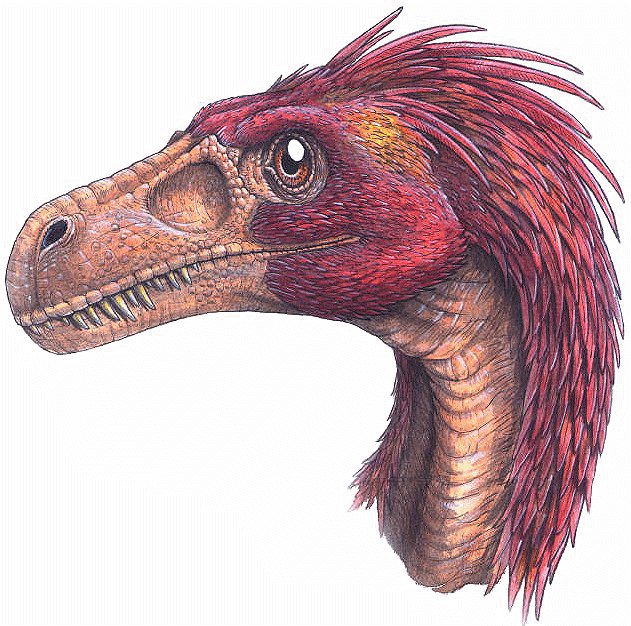|
Dromaeosaurus albertensis
(Matthews and Brown, 1922) |
|
 |
|
Name Means: |
"Swift Running Lizard" |
Length: |
6 feet (1.8 m) |
|
Pronounced: |
Dro-me-o-Saw-rus |
Weight: |
33 pounds (15 kilos) |
|
When it lived: |
Late Cretaceous - 70 MYA |
|
|
|
Where found: |
Alberta, Canada; Montana, USA |
|
|
|
Dromaeosaurus was the original raptor. It was a small, vicious
hunter that had a mouth full of serrated, razor-sharp teeth and a
sharp, hooked claw on each foot that it used to clamp down on its
victims. It was about the size of a large dog. Its jaws were
long and solidly built for its size, and its neck was curved and
flexible. It may have been able to smell its prey, and it probably
possessed a good sense of hearing. Its tail was sheathed in a lattice
of bony rods but was flexible at the base, allowing it to be carried
in a sharply upturned aerial like position. Its remarkably large eyes
gave it excellent vision. Its vicious sickle like claws, although
shorter than those of other dromaeosaurs, still gave it a distinct
advantage over most of its prey.
The first and only good Dromaeosaurus remains were found by
Barnum Brown on the south bank of the Red Deer River in 1914. It
was named by Matthews and Brown in 1922. It was the first
dromaeosaur to be discovered and its name was later used for the
family.
When first discovered, Dromaeosaurus was hard to
classify. It had such large foot bones that it was thought to be a
much larger dinosaur. It had a large brain for its size, large eyes
and grasping hands. Because of this, scientists thought that it was
more than twice its actual size. It wasn't until almost 50 years after
the discovery of the type specimen that it was formally classified
into its own family. All the other raptor dinosaurs, such as
Deinonychus and
Velociraptor, are members of the
dromaeosaur family. Several later discoveries
disclosed Dromaeosaurus teeth among the bones of much larger
dinosaurs. This led to speculation that dromaeosaurs attacked larger
animals, but the teeth may simply have washed into the site.
Dromaeosaurus differs from most other
Dromaeosauridae in having a short, massive skull, a deep mandible,
and large, straight teeth. In these respects Dromaeosaurus
resembles the tyrannosaurs. A few bones are known from the hindlimb,
they indicate that Dromaeosaurus was a fairly massive animal
for its size. Exactly how it lived and what it ate are still open to
speculation. The teeth show fairly heavy wear and seem to be used for
crushing and tearing rather than slicing through flesh; it is possible
that Dromaeosaurus was more of a scavenger than other small
theropods.
Dromaeosaurus seems to have become extinct about 70 million years
ago, well before the Cretaceous Tertiary Boundary. The
type species is D. albertensis. The other species, lacking
in material, may well be synonymous with it. |
D.
albertensis Matthew and Brown, 1922 (type) .
D. cristatus Cope, 1877/Osborn, 1902 and D. minutus
Marsh, 1892 are both nomina dubia included
with the
corresponding Troodon spp.
D. explanatus Cope, 1876/Kuhn, 1939 is a nomen dubium included
with Paronychodon explanatus.
D. falculus Cope, 1876/Olshevsky, 1978 is a nomen dubium that includes Laelaps falculus, Deinodon falculus
and Dryptosaurus
falculus.
D. gracilis Marsh, 1888/Matthew and Brown, 1922 is a nomen dubium that includes Coelurus gracilis.
D. laevifrons Cope, 1877/Matthew and Brown, 1922 is a nomen dubium that includes Laelaps laevifrons,
Deinodon laevifrons and Dryptosaurus
laevifrons.
D. lateralis Cope, 1876 is a nomen dubium included
with Deinodon lateralis. |
|
|
|
|
|
|
|
|
Edugraphics.Net | Feenixx Publishing |
|
|
|
|
![]()
